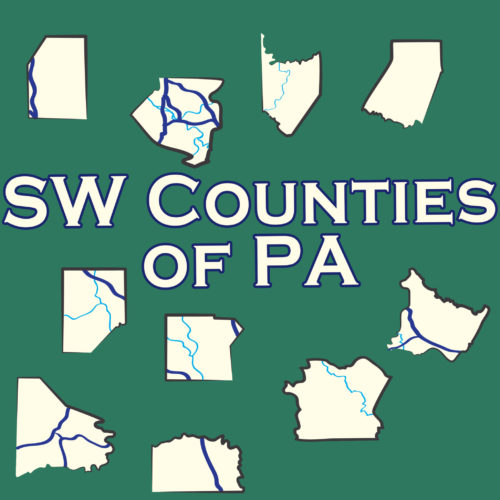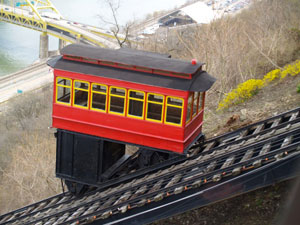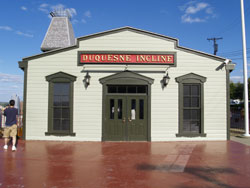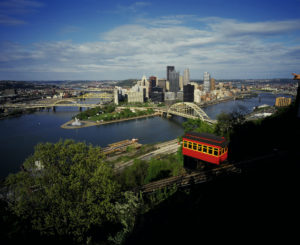
Pittsburgh: East Coast Hollywood
July 1, 2022
SW Counties of Pennsylvania
July 11, 2022
Certainly, there are special buildings and places that are undeniably Pittsburgh, like the Block House, the Cathedral of Learning, or The Carnegie. While many cities have historical sites, unique edifices, or memorable museums, Pittsburgh is one of the few cities in the world with a working incline.
At one time Pittsburgh had over two dozen inclines scaling the hills throughout the region. As many as 15 of them were passenger cars, shuttling commuters up and down the hills surrounding downtown. However, as roads were built and street cars and buses were added, many of the inclines were shuttered. By the early 1960s only two remained: The Monongahela and the Duquesne Inclines. Today, the Duquesne Incline is one of the city’s most beloved and recognizable treasures.
The Rise and Fall
 The Duquesne Incline opened on May 20, 1877. The Duquesne Inclined Plane Company operated the incline from its opening until 1962. After 85 years of operation the incline was in dire need of repairs. When the estimates came in for repairing the incline, the Duquesne Inclined Plane Company (DIPC) decided it was too costly to keep the incline going. The people of Mt. Washington—particularly those living in the Duquesne Heights neighborhood—were shocked to learn that they would be losing their beloved incline. As was the rest of the city. Cy Hungerford, the acclaimed Pittsburgh Post-Gazette cartoonist, noted the incline’s demise with a cartoon depicting one of the incline cars heading downhill wearing a sad face.
The Duquesne Incline opened on May 20, 1877. The Duquesne Inclined Plane Company operated the incline from its opening until 1962. After 85 years of operation the incline was in dire need of repairs. When the estimates came in for repairing the incline, the Duquesne Inclined Plane Company (DIPC) decided it was too costly to keep the incline going. The people of Mt. Washington—particularly those living in the Duquesne Heights neighborhood—were shocked to learn that they would be losing their beloved incline. As was the rest of the city. Cy Hungerford, the acclaimed Pittsburgh Post-Gazette cartoonist, noted the incline’s demise with a cartoon depicting one of the incline cars heading downhill wearing a sad face.
Not willing to part with the incline without a fight, a small group of Duquesne Heights citizens met with the incline’s owner. They struck a deal. The neighborhood would raise the money for repairs; if enough funds were brought in, DIPC would see to the restoration and reopen the incline. The goal was to raise $15,000 (which may seem like an insignificant sum now, but back in 1962, it was quite an uphill climb).
Fortunately, these average-joe citizens put forth an uncommon effort. The local Boy Scouts produced and distributed flyers to every home in the neighborhood. The group sold One Dollar Souvenir tickets door-to-door and hosted bake sales and card parties were. The Duquesne Inclined Plane Company even sold shares of stock for $100 each. As the money came in, the men of the neighborhood began to make what minor repairs they could and started to clean and paint the station houses and cars. Remarkably, the residents raised all the necessary funds within six months.
 And Rise Again
And Rise Again
 Painstaking attention to detail and historical accuracy were employed when restoring the incline. The neighborhood worked with the Pittsburgh History & Landmarks Foundation to restore and rehabilitate the cars, equipment, and both stations to re-establish it as a commuter facility and a visitor attraction. On July 1, 1963, the Duquesne Incline reopened to a joyous reception from the Duquesne Heights residents who had labored so hard to save it and to a jubilant city. Appropriately, Cy Hungerford commemorated the occasion with another cartoon depicting one of the incline cars descending Mt. Washington bearing a beaming smile.
Painstaking attention to detail and historical accuracy were employed when restoring the incline. The neighborhood worked with the Pittsburgh History & Landmarks Foundation to restore and rehabilitate the cars, equipment, and both stations to re-establish it as a commuter facility and a visitor attraction. On July 1, 1963, the Duquesne Incline reopened to a joyous reception from the Duquesne Heights residents who had labored so hard to save it and to a jubilant city. Appropriately, Cy Hungerford commemorated the occasion with another cartoon depicting one of the incline cars descending Mt. Washington bearing a beaming smile.
In 1964, the Port Authority of Allegheny County purchased the Duquesne Incline. But, since it was not economically viable, Port Authority leased the incline to the Duquesne Heights residents for $1 a year. Each year the Port Authority returns that dollar as a donation to the Duquesne Incline. That group of residents then formed the Society for the Preservation of the Duquesne Heights Incline. The Society’s goal is to restore and preserve the incline for future generations. It has transformed the once down-on-its-luck incline into one of the city’s most recognizable symbols and one of Pittsburgh’s most visited attractions.
In 1967, the incline became registered as a historic landmark. The Duquesne Incline is listed as such with the Pittsburgh History & Landmarks Foundation Historic Landmarks, the U.S. National Register of Historic Places in Pennsylvania, and The National Historical Mechanical & Engineering Landmark.

Tourism at the Incline
Today, tourism is the incline’s life’s blood. According to Tom Reinheimer, Office Manager and Marketing and Tour Director, about 482,000 passengers ride on the incline each year. Tourists make up 75 percent of the ridership. “We get tour companies and school students on field trips from all over the area who make it a point to include a visit to The Duquesne Incline on their itinerary,” said Reinheimer.
In 1994, President Bill Clinton and U.K. Prime Minister John Major rode the incline. USA Today once listed the Incline as one of the “Top Ten Sites in the World for Viewing a Cityscape”. Likewise, Mother Nature Network counted in as one of “14 Fabulous Funiculars from Around the Globe”. Margaret Sommerer, a volunteer of 12 years, says, “People come from all over the world to visit the incline. Many of the tourists take my picture. Pictures of me are in places like China, Japan, and Australia.”
The Duquesne Incline also boasts a museum, gift shop, and an observation deck that provides visitors with one of the most breathtaking views of Pittsburgh’s Golden Triangle. And it all runs on donations, membership fees, gift shop proceeds, and fares. Only the conductors, operators, and the small maintenance staff draw a salary. The rest of the daily supervision and work is done by volunteers.
The incline is open 365 days a year, Monday through Friday, 5:30 a.m. to 12:45 a.m., and Sundays and Holidays from 7 a.m. to 12:45 a.m.
The lower station is located at 1197 West Carson Street near Station Square. As the incline traverses Mt. Washington to the upper station, passengers overlook Pittsburgh’s Golden Triangle at the Point.
Some Fun Facts
- The incline was designed by Samuel Diescher, a German engineer.
- The track is 800ft long and the degree of descent is 30.5 degrees. Because the cars are pulled by motorized cables and do not rely of traction, the incline operates even when it’s snowy.
- The cables are changed every two years. The ones that are removed are tested to see the extent of the wear and tear. They could probably use each cable for 20 years, but the preservation society prefers to keep things safe.
- The Society for the Preservation of the Duquesne Heights Incline had a sprinkler system installed, despite records showing that there has never been a fire at the Duquesne incline.
- When the incline was built, electricity was not available, and so it was powered by steam. The incline was electrified in the 1930s. In case of a power failure, the incline has diesel generators to keep it in service. The whole city could be suffering a black out, but the incline would still be working.
- The cars accommodate 20 people, and even during hot summer days, the cars usually are comfortable as you get a nice breeze as you ascend or descend the hill.




